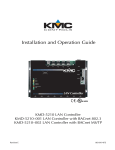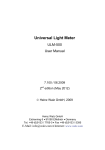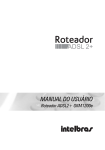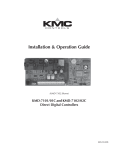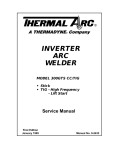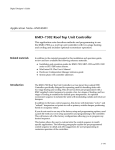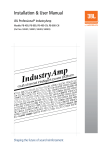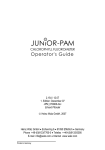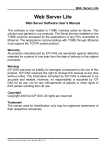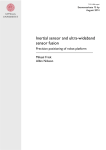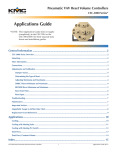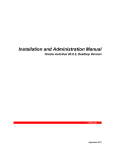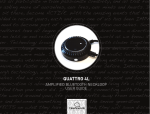Download and KMD-5270 - KMC Controls
Transcript
Installation and Operation Guide KMD-5205 LanLite Controller KMD-5270 WebLite Controller Revision J 909-019-01J KMC Controls Important notices ©2013, KMC Controls, Inc. WinControl, NetSensor, and the KMC logo are registered trademarks of KMC Controls, Inc. TotalControl, BACstage, and FullBAC are trademarks of KMC Controls, Inc. All rights reserved. No part of this publication may be reproduced, transmitted, transcribed, stored in a retrieval system, or translated into any language in any form by any means without the written permission of KMC Controls, Inc. Printed in U.S.A. Disclaimer The material in this manual is for information purposes only. The contents and the product it describes are subject to change without notice. KMC Controls, Inc. makes no representations or warranties with respect to this manual. In no event shall KMC Controls, Inc. be liable for any damages, direct or incidental, arising out of or related to the use of this manual. KMC Controls P.O. Box 497 19476 Industrial Drive New Paris, IN 46553 U.S.A. TEL: 1.574.831.5250 FAX: 1.574.831.5252 E-mail: [email protected] 2 Revision J KMD-5205 and KMD-5270 Installation and Operation Contents Section 1 About the controllers Introduction .......................................................................................................................... 5 Internet operation ................................................................................................................ 5 BACnet 8802-3 option ......................................................................................................... 5 Modbus option ..................................................................................................................... 5 Specifications ........................................................................................................................ 6 Models and options ........................................................................................................... 10 Accessories and replacement parts ................................................................................. 10 Controls and connections ................................................................................................. 11 Safety considerations ........................................................................................................ 12 Section 2 Installing the controllers Mounting ............................................................................................................................ 13 Connecting inputs ............................................................................................................. 13 Connecting outputs ........................................................................................................... 14 Connecting to networks .................................................................................................... 15 KMC Tier 1 networks ........................................................................................................ 15 KMC Tier 2 networks ........................................................................................................ 15 BACnet 8802-3 (optional) ................................................................................................. 17 Modbus (optional) ............................................................................................................. 18 Connecting power ............................................................................................................. 20 Connecting to a computer through the serial port ....................................................... 21 Connecting to a modem .................................................................................................... 22 Section 3 Operating the controller Lights and indicators ......................................................................................................... 23 Powering the controller .................................................................................................... 24 Maintenance ....................................................................................................................... 24 Replacing the fuse .............................................................................................................. 24 Resetting the controller ..................................................................................................... 25 Section 4 Configuration and programming Initializing with HCM ....................................................................................................... 27 Setting up for BACnet networks ..................................................................................... 30 Control Basic programming for BACnet ........................................................................ 31 Setting up for Modbus networks ..................................................................................... 32 Programming for Modbus in WinControl XL Plus ...................................................... 32 Firewalls and network communications ........................................................................ 33 System time keeping ......................................................................................................... 33 System graphics ................................................................................................................. 34 Revision J 3 KMC Controls Section 5 Using a web browser (KMD-5270 models only) Applicable models ............................................................................................................. 35 Browser requirements ....................................................................................................... 36 Opening the WebLite home page .................................................................................... 36 Viewing and editing .......................................................................................................... 38 PID controllers ................................................................................................................... 40 Trend Logs .......................................................................................................................... 40 Schedules ............................................................................................................................ 42 4 Revision J KMD-5205 and KMD-5270 Installation and Operation SECTION 1 About the controllers This section provides a description and specifications—including the BACnet and Modbus options—for models KMD-5205 LANLite and KMD-5270 WebLite controllers. Safety information is included also. Review this material before installing or operating the controllers. Introduction The KMD-5205 and KMD-5270 both provide programmable control and high-level LAN connectivity for facilities management systems. These powerful, direct-digital-controllers operate on a peer-to-peer, token passing protocol, using either Ethernet or EIA-485 networks. ◆ ◆ Ethernet for KMD Tier 1 controllers and optional BACnet 8802.3 devices. EIA-485 for either KMD Tier 2 or Modbus RTU controllers The operating software in the controllers use a high level, easy to learn programming language to ensure reliability, rapid programming and compatibility with future KMC system enhancements. Internet operation KMD-5270 models only BACnet 8802-3 option The embedded internet server in the KMD-5270 models make them ideal controllers for schools and businesses with an Ethernet infrastructure. System operation can be changed using a standard internet browser such as Netscape or Microsoft® Internet Explorer. In addition to changing settings, you can view system groups, trend and runtime logs with the browser. Models with the BACnet option adds open-system functionality to these controllers. ◆ ◆ Modbus option Revision J BACnet devices see input, output and variables in the controller as BACnet input, output and value objects. When installed on the same Ethernet broadcast domain segment as a BACnet 8802-3 network, use Control Basic to retrieve data from any accessible BACnet object on the internetwork. Connect directly to Modbus RTU equipment with the Modbus option. Modbus registers are mapped to variables in the controller that are then available for use by other KMD controllers, BACnet devices or Control Basic. 5 About the controllers Specifications Specifications KMC Controls Specifications for the KMD-5205 and KMD-5270 series of controllers are subject to change without notice. Inputs Key features Connector Conversion Pulse Counting Input impedance Analog input range Digital input range Pull-up resistors Outputs Key features Connector Conversion Analog output range 8 universal inputs Software selectable for analog or digital signals. Standard and custom units of measure. Pull-up resistors for switch contacts and other unpowered equipment. Removable screw terminal block, wire size 12–22 AWG 12-bit analog–to–digital Up to 1000 Hz 100 kΩ without pull-up resistors 0–5 volts DC, 4–20 milliamperes DC 0–5 volts DC and pulse counting None, 1kΩ and 10kΩ selected with movable jumper 8 universal outputs Software programmable for analog or digital signals. Standard and custom units of measure. Slots for KMC output override boards Removable screw terminal block, wire size 12–22 AWG 12-bit digital-to-analog 0–10 volts DC, 50 milliamperes maximum Programmable features Control Basic programs Networked points in Networked points out PID control loops Program variables Time keeping Tables 10 user-definable program areas 127 from Tier 1 controllers 512 from Tier 2 controllers 64 to Tier 1 controllers 64 to Tier 2 controllers 8 PID control loops 256 — Software selectable as analog or digital with standard and custom units of measure Real-time clock with power backup for 72 hours. Programmable for automatic daylight saving time by date, day of month and time of day. 5 user defined Schedules Weekly schedules Annual schedules 6 8 each with 2 override days 4 Revision J About the controllers Specifications KMD-5205 and KMD-5270 Installation and Operation Logging Trend logs Runtime logs Custom graphics 16 trend logs each supporting up to 6 analog, digital or virtual elements or points. Trend logs displayed as text or graphics. 16 runtime logs with time and date stamp and cumulative runtime 32 system groups each of which can manage 64 points with animated and color graphics. Requires WinControl XL Plus to view and edit graphics. KMD-5270 models serves the background system group graphic to browser accessible web pages. Security Six operator access levels 256 names with passwords Alarms Alarm buffering up to 16 alarms On-board 68-character alarm or maintenance text messages Memory Flash memory Ram Communication ports Ethernet RS-485 Serial Revision J 2 megabyte non-volatile flash memory 2 megabyte with six-hour backup Programs and program parameters are stored in non-volatile memory. One Ethernet 10Base-T port for KMD Tier 1 and optional BACnet 8802.3 Connects to either KMC Tier 2 or Modus RTU controllers. Connector type is removable screw terminal block. Wire size 14–22 AWG Serial 9-pin connector for directly connecting to a computer serial port or optional external modem for remote operation. 7 About the controllers Specifications KMC Controls Supported network protocols KMDigital All WebLite controllers support connections to controllers on KMDigital networks. Tier 1—10Base-T Ethernet port supports connection to 31 KMC Tier 1 controllers. Tier 2—Supports connections to 64 KMDigital controllers on the RS–485 port. KMD Tier 2 is not available on models with Modbus RTU protocol. BACnet Connects to the BACnet internetwork as a BACnet Ethernet 8802.3 device. Modbus Supports connection to Modbus slave controllers over the RS-485 port. RS-485, half-duplex (2-wire) 9600, 19,200 or 38,400 baud. Power loss Compatibility Software Controllers Automatic restart on power failure For full feature capability use WinControl XL Plus 2.1 or later. Compatible with Tier 1 controllers firmware build 2.0 or a later release. Regulatory UL 916 Energy Management Equipment FCC Class A, Part 15, Subpart B CE mark Internet Browser access (KMD-5270 models only) Use a standard internet browser to view and change the following: Inputs. Outputs, Variables, Controllers, System Groups, Trend Logs, Run Time Logs, Weekly and Annual Schedules, Alarm Summary. Requires access to SMTP e-mail server with static IP address. Sends text messages, logs and data points. E-mail Supply voltage 24 volts AC, –15%, +20% 25 VA Environmental limits Operating Shipping Humidity Weight 8 32 to 120°F (0 to 49°C) –40 to 140°F (–40 to 60°C) 0–95% non-condensing relative humidity 16 ounces (454 grams) Revision J About the controllers Specifications KMD-5205 and KMD-5270 Installation and Operation Dimensions A O-R STATUS O-R STATUS H O A H O A O-R STATUS H O A O-R STATUS H O A O-R STATUS H O A 1 2 3 4 5 O-R STATUS H O A O-R STATUS H O A O-R STATUS H O A 6 7 8 B D PWR S-LAN PC COLL Rx Tx C Table 1-1 Mounting dimensions Revision J A B C D Height (not shown) 6.56 in. 9.00 in. 6.00 in. 6.00 in. 0.98 in. 167 mm 229 mm 152 mm 152 mm 25 9 About the controllers Models and options KMC Controls Models and options See Table 1-2 on page 10 for available models and protocols. Table 1-2 Available models Model KMD Tier 1 KMD Tier 2 Browser enabled BACnet 8802.3 Modbus RTU KMD-5205 ◆ KMD-5205-005 ◆ KMD-5205-006 ◆ KMD-5270 ◆ ◆ ◆ KMD-5270-001 ◆ ◆ ◆ KMD-5270-005 ◆ ◆ KMD-5270-006 ◆ ◆ Accessories and replacement parts 10 Protocol ◆ ◆ ◆ ◆ ◆ ◆ ◆ ◆ The following accessories and replacement parts are available from KMC Controls, Inc. Output override boards HPO-6701 HPO-6702 HPO-6703 HPO-6704 HPO-6705 HPO-6802 Triac output Short protected analog output Relay, normally open contacts 4–20mA current loop Relay, normally closed contacts Cover for output boards Power transformer XEE-6111-40 XEE-6112-40 Single-hub 120 volt transformer Dual-hub 120 volt transformer Connecting cables KMD-5673 KMD-5674 Six-foot computer-to-controller cable six-foot modem-to-controller cable Replacement parts 902-600-05 HPO-0054 HPO-0063 Fast-acting, 1.6 Ampere 5 x 20 mm fuse FUSE BULB 863-617-03 (10/Pkg Min Qty) 2-PIN KMD JUMPER (5/Pkg Min Qty) Revision J About the controllers Controls and connections KMD-5205 and KMD-5270 Installation and Operation Controls and connections Before installing a KMD-5205 or KMD-5270, take some time to become familiar with the location of the components of the controller. Pull-up jumpers O-R STATUS H O A O-R STATUS H O A 1 Input terminals Output bank 1 2 O-R STATUS H O A O-R STATUS H O A O-R STATUS H O A O-R STATUS H O A O-R STATUS H O A O-R STATUS H O A 3 Input ground terminals 4 5 Output bank 2 6 RS-485 end-of-line termination switches 7 8 Isolation bulbs Input power RS-485 PWR RS-232 PC COLL Rx Ethernet Power supply fuse S-LAN Power jumper Tx Indicator LEDs Illustration 1-1 Control and connection terminal locations Revision J 11 About the controllers Safety considerations KMC Controls Safety considerations KMC Controls assumes the responsibility for providing you a safe product and safety guidelines during its use. Safety means protection to all individuals who install, operate, and service the equipment as well as protection of the equipment itself. To promote safety, we use hazard alert labeling in this manual. Follow the associated guidelines to avoid hazards. Danger Danger represents the most severe hazard alert. Bodily harm or death will occur if danger guidelines are not followed. Warning Warning represents hazards that could result in severe injury or death. Caution Caution indicates potential personal injury or equipment or property damage if instructions are not followed. Note Notes provide additional information that is important. Detail Provides programing tips and shortcuts that may save time. Danger 12 Revision J KMD-5205 and KMD-5270 Installation and Operation SECTION 2 Installing the controllers This section provides important guidelines for installing KMC direct digital controllers. Review this information carefully for proper installation. Mounting Mount the controller inside of a metal enclosure. KMC Controls recommends using a UL-approved Enclosed Energy Management Equipment Panel such as a KMC model HCO-1034, HCO-1035 or HCO-1036. Insert #6 hardware through the two mounting holes on each side of the controller to securely fasten it to a flat surface. See Dimensions on page 9 for mounting hole locations and dimensions. To maintain RF emission specifications, use either shielded connecting cables or enclose all cables in conduit. Connecting inputs The controllers include eight universal inputs. Each input can be configured with software to receive either analog or digital signals. By using the optional pull-up resistors, either passive or active devices may be connected to the inputs. For additional information, see the application note AN0504L, Connecting inputs and outputs to KMC controllers. Pull-up resistors For passive input signals, such as thermistors or switch contacts, use a pull-up resistor. For KMC thermistors and most other applications place the moveable jumper in the 10K position. 4–20 mA inputs To use a 4–20 current loop input, connect a 250 ohm resistor from an input to ground. The resistor will convert the current input to a voltage which can be read by the controller analog-to-digital converter. Place the moveable pull-up jumper in the NONE position. Pulse inputs Connect pulse inputs under the following conditions: ◆ ◆ Revision J If the pulse input is a passive input such as switch contacts, then place the input pull-up jumper to the 10K position. If the pulse is an active voltage (up to a maximum of +5 volts DC), then place the input pull-up jumper in the NONE position. 13 Installing the controllers Connecting outputs KMC Controls Ground terminals Three input ground terminals are located next to the input terminals. Up to two wires, size 12–22 AWG, can be clamped into each ground terminal. If more than two wires must be joined at a common point, use an external terminal strip to accommodate the additional wires. Connecting outputs All eight outputs are universal and can be configured by software to operate either analog or digital devices. Connect the device under control between the output terminal and one of the ground (G) terminals on the same bank. Override cards For large relays or devices that cannot be powered directly from a standard output, install an output override card. Override cards provide: ◆ ◆ ◆ A wide choice of output signals. A slide switch for automatic or manual control. An LED for assessment of the output state. Install the output override cards in the area under the plastic cover next to the output terminals. The following output cards are available from KMC Controls. Table 2-1 Output override cards Card model number Output type HPO-6701 Triac HPO-6702 0–10 volts DC analog HPO-6703 Normally open contact HPO-6704 4–20 milliampere current loop HPO-6705 Normally closed contact Grounds and Switched Commons When using an output override card, use the SC terminal instead of the ground (G) terminal as signal common. Use the SC terminal in the same output bank as the output terminal. 14 Revision J KMD-5205 and KMD-5270 Installation and Operation Connecting to networks Installing the controllers Connecting to networks Each controller in a KMC digital network may be used as either a stand-alone controller or connected to other controllers in a network. The KMD-5205 and KMD-5270 controllers can be connected to other KMC controllers through two different types of networks. ◆ ◆ Connections to KMD Tier 1 controllers and BACnet 8802–3 devices use standard Ethernet wiring and hardware. KMD Tier 2 controllers and Modbus controllers use EIA–485 wiring and hardware. KMC Tier 1 networks LAN connections Connect a standard Ethernet cable between the Ethernet connector on the controller and a port on a network hub or router. You may connect up to 31 Tier 1 controllers in a system using Ethernet. In addition to allowing the maximum LAN controllers, multiple computers can access the system through the network. See Initializing with HCM on page 27 for Ethernet configuration. KMC Tier 2 networks Connect KMC Tier 2 controllers to a KMD-5205 or KMD-5270 at the RS-485 connector. The KMC Tier 2 network uses shielded twisted pair cable to connect controllers together. See Initializing with HCM on page 27 for configuring a controller for Tier 2 network operation. Note KMD Tier 2 controllers cannot be connected to KMD-5205 or KMD-5270 when the Modus option is enabled. Revision J 15 Installing the controllers KMC Tier 2 networks KMC Controls Tier 2 wiring You may connect up to 64 KMDigital controllers to the RS–485 connector. Use approved shielded cable and the following principles when connecting a controller to a Tier 2 (sub LAN) network: ◆ ◆ ◆ ◆ ◆ ◆ ◆ Use 18 gauge, twisted pair, shielded cable with capacitance of no more than 50 picofarads per foot for all network wiring. Belden cable model #82760 meets the cable requirements. Connect the A terminal in parallel with all other A or -A terminals. Connect the B terminal in parallel with all other B or +B terminals. Connect the shields of the cable together at each controller. Connect the shield to an earth ground at the other end. Use a KMD–5575 repeater if the cable length will exceed 4000 feet (1220 meters). Use no more than seven repeaters per Tier 2 network. Place a KMD–5567 surge surpressor in the cable where it exits a building. A B A B G G A B A B G G G B A Earth ground G B A Ground shield in one place only. Illustration 2-1 Connecting controllers to a Tier 2 network Tier 2 end of line termination switches The controllers on the physical ends of the RS-485 wiring segment must have end-of-line termination installed for proper network operation. Set the end-of-line termination to On using the EOL switches. The KMD-5205 and KMD-5270 end-of-line termination is set with two switches located near the RS–485 connector. Termination in other KMC controllers may be set with moveable jumpers or fixed resistors. 16 Revision J Installing the controllers BACnet 8802-3 (optional) KMD-5205 and KMD-5270 Installation and Operation Note Set the End-of-Line termination at the controllers where only one wire is attached to the A and B terminals. O-R STATUS H O A 1 O-R STATUS H O A O-R STATUS H O A O-R STATUS H O A O-R STATUS H O A O-R STATUS H O A 2 3 4 5 6 O-R STATUS H O A O-R STATUS H O A 7 8 WD PWR S-LAN PC COLL Rx Tx Termination On Termination switch Illustration 2-2 Termination switches O-R STATUS H O A 1 O-R STATUS H O A O-R STATUS H O A 2 3 O-R STATUS H O A O-R STATUS H O A 4 5 O-R STATUS H O A O-R STATUS H O A O-R STATUS H O A 6 7 8 PWR S-LAN PC COLL Rx Tx Set end-of-line termination to On in these controllers only O-R STATUS H O A 1 O-R STATUS H O A O-R STATUS H O A 2 3 O-R STATUS H O A O-R STATUS H O A 4 5 O-R STATUS H O A O-R STATUS H O A O-R STATUS H O A 6 7 8 PWR S-LAN PC COLL Rx Tx Illustration 2-3 End-of line termination BACnet 8802-3 (optional) Connect models with the BACnet option to the BACnet internetwork through the same Ethernet 10Base-T connection as the Tier 1 connection. For access to devices on a BACnet internetwork you must do the following: ◆ ◆ ◆ Revision J The BACnet internetwork must include at lease one 8802-3 network. The controller must be connected to the same Ethernet broadcast domain segment as one of the BACnet 8802-3 networks. If the internetwork does not include an 8802-3 network, install a router to route traffic from the existing BACnet network protocols to Ethernet 8802-3. For internetworks that include MS/TP or BAcnet IP, use a BAC-5050. For addition details on BACnet networks, see application note AN0404A, Planning BACnet Internetworks, which is available on the KMC web site. 17 Installing the controllers Modbus (optional) Modbus (optional) KMC Controls Connect Modus slave controllers to a KMD-5205 or KMD-5270 at the RS-485 connector. The Modbus network uses shielded twisted pair cable to connect controllers together. To set up the controller, see Initializing with HCM on page 27 and Setting up for Modbus networks on page 32 for configuration details. Modbus wiring Connect Modbus slave devices to the RS-485 connector. Use approved shielded cable and the following principles when connecting a controller to a Modbus network: ◆ ◆ ◆ ◆ ◆ ◆ Use 18 gauge, twisted pair, shielded cable with capacitance of no more than 50 picofarads per foot for all network wiring. Belden cable model #82760 meets the cable requirements. Connect the A terminal of the KMD controller in parallel with the minus (-) terminals on the Modbus devices. Connect the B terminal of the KMD controller in parallel with the plus (+) terminals on the Modbus devices. Connect the shields of the cable together at each controller. Connect the shield to an earth ground at one end only. Place a KMD-5567 surge surpressor in the cable where it exits a building. Note In addition to these Modus wiring requirements, verify equipment specific Modbus wiring requirements in the manuals supplied with the Modus devices. + + Modbus devices + + G B A G B A KMD-5205 or KMD-5270 with Modbus Ground shield in one place only. Illustration 2-4 Connecting the Modbus network 18 Revision J KMD-5205 and KMD-5270 Installation and Operation Installing the controllers Modbus (optional) Modbus end-of-line termination switches The controllers on the physical ends of the Modus wiring segment must have end-of-line termination installed for proper network operation. For the KMD controllers the end-of-line termination is set with two switches located near the RS-485 connector. Set the end-of-line termination to On using the EOL switches. End-of-line termination for the connected Modbus devices may be set with moveable jumpers or fixed resistors. Verify termination methods for the Modbus devices in the manuals supplied with the Modbus devices. Note Set the end-of-line termination at the controllers where only one wire pair is attached to the A and B terminals. Set end-of-line termination to On in these controllers only Illustration 2-5 End-of-line termination Revision J 19 Installing the controllers Connecting power Connecting power KMC Controls The controllers require an external, 24 volt, AC power source. Use the following guidelines when choosing and wiring transformers. ◆ ◆ ◆ ◆ 20 Use a KMC Controls Class–2 transformer of the appropriate size to supply power to the controllers. When installing a controller in a system with other controllers, you may power multiple controllers with a single transformer as long as the total power drawn from the transformer does not exceed its rating and phasing is correct. If several controllers are mounted in the same cabinet, you can share a transformer between them provided the transformer does not exceed 100 VA or any regulatory requirements. Do not run 24 volt, AC power from within an enclosure to external controllers. Revision J KMD-5205 and KMD-5270 Installation and Operation Connecting to a computer through the serial port Installing the controllers Connecting to a computer through the serial port Multiple computers may access the same controller at the same time. However, unpredictable operation may occur if two or more operators are making simultaneous changes. To initialize or address the controller with the KMC Hardware Configuration Manager or to program with WinControl XL Plus, connect a KMD-5673 cable between a serial port on the computer and the RS-232 port on the controller. ◆ ◆ See Illustration 2-6 for cable details. See the section Configuration and programming on page 27 for procedures on initializing and programming the controller. Nine-pin, female D-shell connector 2 2 3 3 5 5 Illustration 2-6 Computer to controller cable O-R STATUS O-R STATUS H O A H O A O-R STATUS H O A O-R STATUS H O A O-R STATUS H O A 1 KMD–5673 cable 2 3 4 5 O-R STATUS H O A O-R STATUS H O A O-R STATUS H O A 6 7 8 PWR S-LAN PC COLL Rx Tx Illustration 2-7 Direct connection to KMD-5205 and KMD-5270 Revision J 21 Installing the controllers Connecting to a modem Connecting to a modem KMC Controls By adding an optional modem to the controller, an off-site computer can access the controller through a dial-up connection. The modem connection also supports dial-in and the Control Basic functions TPAGE and NPAGE. If the modem function is enabled, the serial port is not available for direct connection with a computer. Detail KMC Controls recommends using U.S. Robotics modems for off-site communications. KMC does not offer support for other modem installations. To install a modem: 1. Use HCM to configure the controller for the modem function. See Initializing with HCM on page 27 for setup details. 2. Connect a KMD-5674 computer-to-modem cable between the KMD-5569 modem and the nine-pin modem connector on the controller. 3. Connect the modem to a telephone line dedicated to the network system. 4. Verify the configuration switches on the back of the modem are in the following positions. Table 2-2 Modem configuration switches 1 2 3 4 5 6 7 8 Up Up Down Down Up Up Up Down O-R STATUS H O A O-R STATUS H O A 1 2 O-R STATUS H O A O-R STATUS H O A O-R STATUS H O A O-R STATUS H O A 3 4 5 6 KMD–5674 cable O-R STATUS H O A O-R STATUS H O A 7 8 PWR S-LAN PC COLL Rx Tx Illustration 2-8 Modem connection to KMD-5205 and KMD-5270 Detail Use only the KMD-5674 cable between the controller and the modem. A standard modem cable will not work. 22 Revision J KMD-5205 and KMD-5270 Installation and Operation SECTION 3 Operating the controller This section provides general operating parameters of your KMC controller and a detailed description of the front panel display. Lights and indicators Isolation bulbs Two small bulbs located next to the RS-485 connector are protective isolation bulbs for the Tier 2 networks. These bulbs serve three functions: ◆ ◆ ◆ When illuminated they indicate improper network phasing. Improper phasing occurs when the ground potential of the controller is higher than the phase or the ground potential of other Tier 2 or Modbus controllers on the network. The bulbs protect the controller from damage by limiting the network signal. If voltage or current exceeds safe operating condition, the bulbs will open the connections between the controller and the network. By pulling the bulbs from their sockets you can disconnect the controller from the network. O-R STATUS H O A O-R STATUS H O A 1 Termination switch 2 O-R STATUS H O A O-R STATUS H O A O-R STATUS H O A 3 4 5 O-R STATUS H O A O-R STATUS H O A O-R STATUS H O A 6 7 8 Reset button Isolation bulbs WD PWR S-LAN PC COLL Rx Tx Power jumper Indicator LEDs Illustration 3-1 Controls and indicators Revision J 23 Operating the controller Powering the controller KMC Controls LED indicators Six LEDs on the front of the controller display system status. Use the LEDs to confirm proper operation or as an aid when troubleshooting. PWR Flashes green during normal operation. The normal cycle is one second on and one second off. S-LAN Momentarily flashes yellow during the time when data is being transmitted to either the KMD Tier 2 network controllers or to the connected Modbus devices. PC Flashes when sending or receiving data from a computer. COL Momentarily flashes red when a collision occurs in Ethernet traffic. Rx Flashes green when Ethernet traffic is being received. Tx Flashes green when Ethernet traffic is being transmitted. Powering the controller Use the jumper located next to the power terminal to disconnect the 24 volt AC power from the controller while making wiring changes. Remove the power terminal or disconnect the power feeding the transformer before removing the controller. The controller begins operation as soon as power is applied. Maintenance The controller does not require routine maintenance. If cleaning is required, wipe with a soft, damp cloth and mild soap. Replacing the fuse If a fuse opens, investigate the cause, and then replace the fuse. To replace the fuse: 1. Remove the power connection to the module. 2. Carefully pull out the open fuse from the fuse holder. 3. Carefully snap an identical 1.6 ampere, fast-acting, fuse into the fuse holder. 4. Reconnect the power. 24 Revision J KMD-5205 and KMD-5270 Installation and Operation Resetting the controller Operating the controller Resetting the controller Use the reset button for either of the following functions. ◆ ◆ Restore the modem settings. Restore all configuration settings to the factory default settings. Caution Restoring the controller erases all programs and point configuration. Connect to the controller through Ethernet or a dial-up modem and use either WinControl XL Plus or TotalControl to save the programming in a panel file before resetting the controller. To restore only the modem settings A controller that has been set for modem operation with HCM cannot directly connect to a computer at the RS–232 port unless it is changed with the reset button. To change the controller from modem connection to direct computer connection do the following: 1. Remove the plastic cover surrounding the six LEDs. 2. Press the reset button for one second and then release it. Restoring to factory settings Restoring a controller to factory settings changes the controller as follows: ◆ Removes all programming. ◆ Removes all configuration settings. ◆ Restores the controller to factory default settings. Caution Resetting the controller erases all configuration and programming. After resetting to factory settings, you must configure and program the controller to establish normal communications and operation. To reset the controller to factory settings. 1. If possible, use WinControl XL Plus or TotalControl Design Studio to backup the controller. 2. Remove the plastic cover surrounding the six LEDs. 3. Remove the power jumper. See the illustration Controls and indicators on page 23 for the location. 4. Press and hold the red restart button. 5. Replace the power jumper while continuing to hold the restart button. 6. Release the restart button when the SUBLAN and PC LEDs illuminate. Revision J 25 Operating the controller Resetting the controller 26 KMC Controls Revision J KMD-5205 and KMD-5270 Installation and Operation SECTION 4 Configuration and programming This section lists initialization settings and describes programming functions that are unique to configuring the KMD-5205 and KMD-5270 controllers. Other programming features and more detailed instructions are covered in the WinControl XL User’s Plus Reference Manual. Initializing with HCM Before a controller is placed into service, it must be initialized and addressed with the KMC Hardware Configuration Manager (HCM) software. HCM is distributed on the WinControl XL software CD; complete operating instructions are included in the Hardware Configuration Manager help files or the HCM Reference Guide available on the KMC Controls web site. Caution The Hardware Configuration Manager sets all controllers on the Tier 2 network to the same parameters. To prevent disruption to other controllers on the network, disconnect the network cables at the RS-485 port or remove the isolation bulbs on the controller prior to starting HCM. Note Ethernet settings do not take effect in a controller until the power is cycled. 1. Unplug the Tier 2 or Modbus network connection from the RS-485 port. 2. Connect a serial cable between the controller and the computer on which HCM will run. See Connecting to a computer through the serial port on page 21. 3. Start HCM and establish communications with the controller. 4. Make the entries as described in the section KMC digital network configuration on page 28. 5. Set up the Ethernet routing table. See Ethernet routing table on page 29. 6. On applicable models, do the following: • Enter BACnet parameters. See Setting up for BACnet networks on page 30. • Set up the Modus communications. See Setting up for Modbus networks on page 32. 7. Return the network connection to the RS-232 port. Revision J 27 Configuration and programming Initializing with HCM KMC Controls 8. Cycle the power to the controller. The controller can now be connected to a network and additional programming can be performed with WinControl XL Plus or TotalControl. KMC digital network configuration The entries in the table HCM Configuration Screen setup fields on page 28 are required for controller-to-controller communications on a either KMD Tier 1 or KMD Tier 2 networks. Table 4-1 HCM Configuration Screen setup fields Setting Description Address Enter the address that is assigned to the controller on the KMD Tier 1 network. Valid entries are 1–31. Last Panel Not applicable on any KMD-5205 or KMD-5270 models. SubLAN A Sets the connection speed of the Tier 2 port to which the controller is connected. Set the baud to match the baud of the other controllers on the Tier 2 network. Modem Select to indicate a modem is connect to the nine-pin serial connector. If Modem is selected, a computer cannot be directly connected to the nine-pin connector. Modem String The controller automatically transmits initialization strings for U.S. Robotics modems. If you are using a different modem, enter the initialization string here. This can normally be found in the modem manual. The default initialization string is AT&A &B1 &C1 &D2 &H1 &K0 &R. Computer Port Enter the communication speed for a PC is directly connected to this port or the modem-to-computer baud if a modem is connected to the controller. SMPT IP Address Enter the IP address of the e-mail SMTP server. This address is required to send e-mail with KMD-5270 models. The address is supplied by the network system administrator. 28 Revision J KMD-5205 and KMD-5270 Installation and Operation Configuration and programming Initializing with HCM Ethernet routing table The Ethernet routing table is a list that associates the KMC network addresses assigned to Tier 1 controllers with the IP addresses required by the LAN protocol. If the controller is not configured correctly, it will not communicate with other controllers and may cause problems with the rest of the network. Before starting the HCM initializing process you will need information about the controller and the LAN which is listed in Table 4-2. Table 4-2 Tier 1 controller Ethernet settings in HCM Setting Description IP address Supplied by network administrator. Enter the address next to the panel address of the LAN Controller. MTU 1400 or as supplied by system administrator Gateway Use default (255.255.255.255) unless a router (gateway) is located between two Tier 1 controllers. The router IP address is supplied by the network system administrator. MAC address The MAC address is located on the white label on the front of the controller. MAC addresses for KMC Controls products begin with 00-D0-6F. Broadcast sever Check if this controller is a broadcast server. Interval Set the interval for the broadcast message. The broadcast message is for KMD controllers and not a LAN broadcast message. Subnet mask Set the Subnet Mask address to 255.255.255.0. or as supplied by network system administrator. Note Ethernet settings do not take effect in a controller until the power is cycled. Ethernet troubleshooting If the controller does not appear Network Status in the WinControl program, try the following. 1. Obtain a crossover cable (available in most stores that carry network products). 2. Connect the crossover cable between the Ethernet connection on your computer and the Ethernet connector on the LAN Controller. 3. Open an MS-DOS window on your computer and Ping the controller’s IP address. If the controller is operating correctly, you should receive a response to the ping command. If you are unfamiliar with the above steps, contact KMC Controls for assistance Revision J 29 Configuration and programming Setting up for BACnet networks Setting up for BACnet networks KMC Controls These topics apply only to the following models: ◆ ◆ ◆ KMD-5205-006 KMD-5270-001 KMD-5270-006 If the controller is licensed for BACnet and connected to a BACnet network, the controller must be configured to communicate with the network. Table 4-3 BACnet settings in HCM Setting Description Instance The device instance number as assigned by the BACnet system designer. Instance numbers are required, must be unique among all devices on the internetwork and range from 0 to 4,194,303. Name A required 16-character label of the device. Name must be unique among all devices on the internetwork. The set of characters used in Name is restricted to printable characters. Location Optional information used to further identify a piece of equipment. Description Optional information used to further identify a piece of equipment. APDU Timeout Indicates the period—in milliseconds— between retransmissions of an APDU requiring an acknowledgement for which no acknowledgment has been received. The default value is 3000 milliseconds. Max Master Not applicable to KMD-5205 or KMD–5270 models. Token Timeout Not applicable to KMD-5205 or KMD–5270 models. Detail BACnet device settings are covered in more detail in BACstage or TotalControl help. The BACstage and TotalControl reference guides are available also in Adobe Acrobat format on the KMC Controls web site. 30 Revision J Configuration and programming Control Basic programming for BACnet KMD-5205 and KMD-5270 Installation and Operation Control Basic programming for BACnet These topics apply only to the following models: ◆ KMD-5205-001 ◆ KMD-5270-001 ◆ KMD-5205-006 ◆ KMD-5270-006 Control Basic programming for BACnet For Control Basic programming, the KMD–5270 models support the BACnet object types that are listed in Table 4-4. Table 4-4 Supported BACnet object types Mnemonic Object type AI Analog Input AO Analog Output BI Binary Input BO Binary Output AV Analog Value BV Binary Value Program the controllers as you would other KMD series controllers. Observe the following details when programing an interface to a BACnet internetwork: ◆ ◆ ◆ ◆ Only input, output and variable points within a BACnet licensed controller appear as objects in a device on the BACnet internetwork. A point configured as a KMD digital point will appear as a BACnet binary object. Analog points appear as analog objects. To be visible as an object to BACnet devices, configure the KMD point with both a description and a label. Use BAC-SET, BAC-GET and BAC-RLQ in Control Basic to read and write other objects on other BACnet devices. KMC Controls recommends that all BACnet services have adequate error handling protocols within your control program. The following Control Basic code segment demonstrates reading the state of binary input BI8 in a BACnet device with instance number 1. Caution The WAIT statement in the following example is required. Do not delete it or the program will not run correctly. Example: Revision J 250 G = BAC-GET( 1 , BI8 ) : REM BACnet read 260 ON-ERROR 280 : REM If error, bad read, don’t use it 270 1-VAR16 = G : REM Read was good, use the value. 280 WAIT 0:00:15 : REM Release so other CB programs can run 290 END 31 Configuration and programming Setting up for Modbus networks KMC Controls Access to the controllers from BACnet To access the BACnet licensed controller, use a BACnet operator workstation such as BACstage. ◆ ◆ ◆ ◆ ◆ Setting up for Modbus networks The WebLite will appear in the BACstage device list but cannot be selected. Its objects are not accessible for configuration from the BACstage Object menu. The configured points within the WebLite are the only points visible in BACnet. In BACstage, use BACnet Read/Write Property under the System menu in BACstage to manually view or change properties. In TotalControl the BACnet licensed controllers are added to the Network Manager list. KMC BACnet controllers and third-party devices may read and write to the objects in the WebLite with off-panel reads and writes. These topics apply only to the following models: ◆ KMD-5205-005 ◆ KMD-5270-005 ◆ KMD-5205-006 ◆ KMD-5270-006 Set the following Modbus communication parameters with HCM. All Modbus devices connected to the same network—including the KMD-5205 and KMD 5270 models—must be set to the same mode, baud and parity. Table 4-5 Modbus settings in HCM Programming for Modbus in WinControl XL Plus Setting Description Mode Select only RTU. Baud Set to 9600, 19,200 and 38,00 baud. Data Set to even, odd or no parity bits Use WinControl XL Plus to map Modbus registers to variables in the KMD-5205 and KMD-5270 Modbus licensed controllers. Once the registers are mapped to variables, the variables are handled with Control Basic to read from and write to the registers. The procedures for mapping the registers to variables are covered in WinControl XL Plus help and the WinControl XL Plus Reference manual. Note WinControl XL Plus 2.1 or later is required to map Modbus registers to variables in the KMD-5205-005 and KMD-5270-005 controller. 32 Revision J Configuration and programming Firewalls and network communications KMD-5205 and KMD-5270 Installation and Operation Firewalls and network communications Firewalls are commonly installed on networks to prevent unauthorized traffic or electronic probes from entering the network. If the controller must communicate with a network where a firewall is in place, the following actions must be taken. Tier 1 controllers communicate through one of three Ethernet Ports: Tabel 4-6 Firewall ports Connection UDP Port WinControl to Tier 1 controller 21068 Tier 1 controller to Tier 1 controller 21069 Tier 1 controller to Tier 1 controller 21070 These ports must be open for communications to pass through a firewall. If the controller resides behind a Network Address Translation (NAT) router, the IP address for the controller must be preceded by the lowercase letter ‘r’ in the WinControl system menu. (For example, r128.1.1.5.) Adding this prefix letter will cause WinControl to disregard the IP table and download from the panel itself. Note If you use this method you will only be able to connect one Tier 1 controller through the router. System time keeping Revision J The controllers feature real-time clocks. Once the clock is set with WinControl XL, the controller maintains accurate time even during power loss. A KMC digital network uses the lowest addressed Tier 1 controller with a real-time clock as the system time keeper. 33 Configuration and programming System graphics System graphics KMC Controls These topics apply only to the following models: ◆ KMD-5270 ◆ KMD-5270-005 ◆ KMD-5270-001 ◆ KMD-5270-006 The KMD-5270 WebLite models can store up to eight system group background graphics which can then be served to a standard web browser. Use the following procedure in WinControl XL Plus to make a graphic available for browser access. Detail WinControl XL Plus 2.1 or later is required to load browser graphics into a KMD–5270 WebLite. 1. Connect to the controller with WinControl XL Plus over Ethernet. 2. Choose Control menu, System Groups. and then Graphics. 3. Enter the file name of the background graphic to be stored in the KMD-5270 for viewing with a web browser. 4. Enter the same name in the Bitmap/JPEG column in the System Groups list window. Illustration 4-1 Web graphics file list Caution A background graphics file name may be compatible with WinControl XL Plus but not with the browser. WinControl XL Plus will send a background graphic with an incompatible file name to the controller but the browser may not display it. Use the following guidelines for best results. ◆ ◆ ◆ ◆ ◆ 34 Use the file name without the extension. The file type must be JPG format and cannot be larger than 50kB. Place the file in the Pictures directory in the job folder. This is the same location for other system group graphics. Use only file names that are compatible with web browsers. If unsure about browser compatibility, use only letters and numbers. File names are limited to 10 characters by WinControlXL Plus. Revision J KMD-5205 and KMD-5270 Installation and Operation SECTION 5 Using a web browser (KMD-5270 models only) This section explains how to view and control a KMD-5270 with a web browser. Through the embedded HTTP server in the KMD-5270, you can use a web browser to view and make changes to the following functions in the controller. Table 5-1 WebLite view and change functions Function Control System Groups Views text and background graphics. Inputs Change value and manual mode status Outputs Change value and manual mode status Variables Change value and manual mode status PID Controllers Change value and manual mode status Weekly Schedules Change times Annual Schedules Change dates These functions are fully described in the section The Control Menu of the WinControl XL Plus User’s Manual. Applicable models Revision J The topics in this section apply only to the following models: ◆ KMD-5270 ◆ KMD-5270-005 ◆ KMD-5270-001 ◆ KMD-5270-006 35 Using a web browser (KMD-5270 models only) Browser requirements Browser requirements KMC Controls Use only Microsoft Internet Explorer to view the web pages in a KMD-5270 controller. The browser requires the Java Virtual Machine, a product of Oracle, to view the trend graphs in the controller. Download the Java Virtual Machine at the following address. www.oracle.com. If you are using Internet Explorer version 10, which will only run on Windows 7 or Windows 8, you must enable the Compatibility View to get the WebLite web pages to work correctly. If you open the WebLite web page and the Login button is not present, change the compatibility mode by clicking the Compatibility icon in the address bar. Click to change to compatibility mode. Illustration 5-1 Changing to compatibility mode in IE 10. Opening the WebLite home page To access a WebLite with a web browser, open a browser window and then enter the IP address for the controller in the address bar. The WebLite home page opens. Note Two IP addresses may be assigned to a WebLite. The network system administrator will provide the address. ◆ ◆ Use the internal IP address if you are connected to the same network as the WebLite. Use the IP address assigned for viewing with a browser if you are connecting to the WebLite through an internet service or network firewall. Enter IP address Click to log in Enter operator name and password Illustration 5-2 WebLite home page 36 Revision J Using a web browser (KMD-5270 models only) Opening the WebLite home page KMD-5205 and KMD-5270 Installation and Operation Log in and security When the home page is open, click Login and then enter your user name and password. Only assigned operators can view or make changes to a WebLite controller. Security levels are assigned with WinControl XL Plus and correspond to WebLite permissions as follows: Table 5-2 Password permissions Operator level Permission 1 View only 3 Changes permitted only to the initial system group that opens for the operator at sign-on. 5 View and make changes After a logging in, the home screen displays a list of available functions. Click to log out Choose available functions from the Controller Data list Illustration 5-3 WebLite home page Log out Click the Logout button in the upper right corner of the home page to close the connection with the WebLite. Logging out maintains security and prevents unauthorized modifications to the system. Revision J 37 Using a web browser (KMD-5270 models only) Viewing and editing Viewing and editing KMC Controls Controlling a system through a WebLite is limited to making changes to values, setting the state of manual overrides and changing times and dates in schedules. When you choose a point such as Input, a monitor window opens. Below the data displayed in the window is an edit link which opens an additional window with the edit page. Edit link Illustration 5-4 View only monitor window Note Descriptions, labels and units can be changed only by using WinControl XL Plus. 38 Revision J KMD-5205 and KMD-5270 Installation and Operation Using a web browser (KMD-5270 models only) Viewing and editing To make changes to values: 1. Click Edit. The Edit window opens. 2. Enter a new value. 3. Click Ok and the change is sent to the controller. Calculator button Click OK to send changes Calculator pop-up Click Reset to restore to original state Illustration 5-5 Input edit window Clicking the calculator button opens an additional window with calculator functions. The value in the calculator pop-up is sent to the edit page when you close the calculator pop-up or click Ok. The change is not sent to the controller until you click OK in the edit page. Revision J 39 Using a web browser (KMD-5270 models only) PID controllers PID controllers KMC Controls PID controllers are managed the same as the input function described in Viewing and editing on page 38. Illustration 5-6 PID control loop Trend Logs Trend logs may be viewed as either a table or graph. Note Viewing trend log graphs require the Sun Microsystems Java Virtual Machine to be installed on your computer. Download the Virtual Machine at http:// java.sun.com/getjava/download.html To view a trend log: 1. Choose Trend Log from the Controller Data list. A trend log list window opens. 2. Choose a trend log from the list. A window opens and displays the trend log in table format. 3. Click Open Graph. A new window opens in which the controller will graph the data. 4. Passing the cursor over a point on the graph displays the data value and the time it was collected in the Pointer Coordinates box. To zoom in on a specific detail: 1. Left click and drag from left to right over the points you want to examine. 40 Revision J KMD-5205 and KMD-5270 Installation and Operation Using a web browser (KMD-5270 models only) Trend Logs 2. Click No Zoom to return to normal view. Illustration 5-7 Trend log graph Revision J 41 Using a web browser (KMD-5270 models only) Schedules Schedules KMC Controls Weekly and annual schedules are managed much the same as with WinControl. The method for editing a weekly schedule is described in Viewing and editing on page 38. Illustration 5-8 Weekly and annual schedules 42 Revision J










































